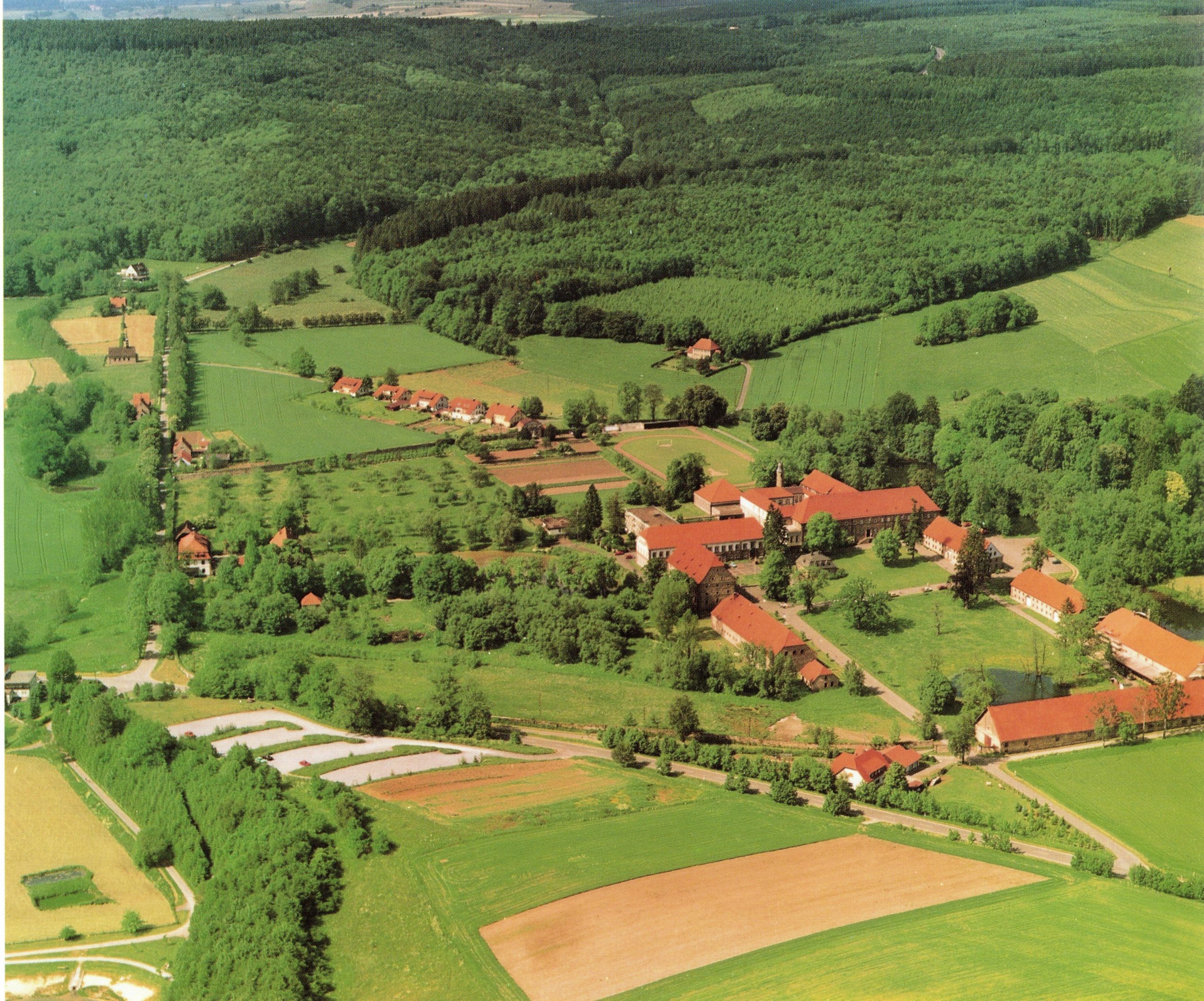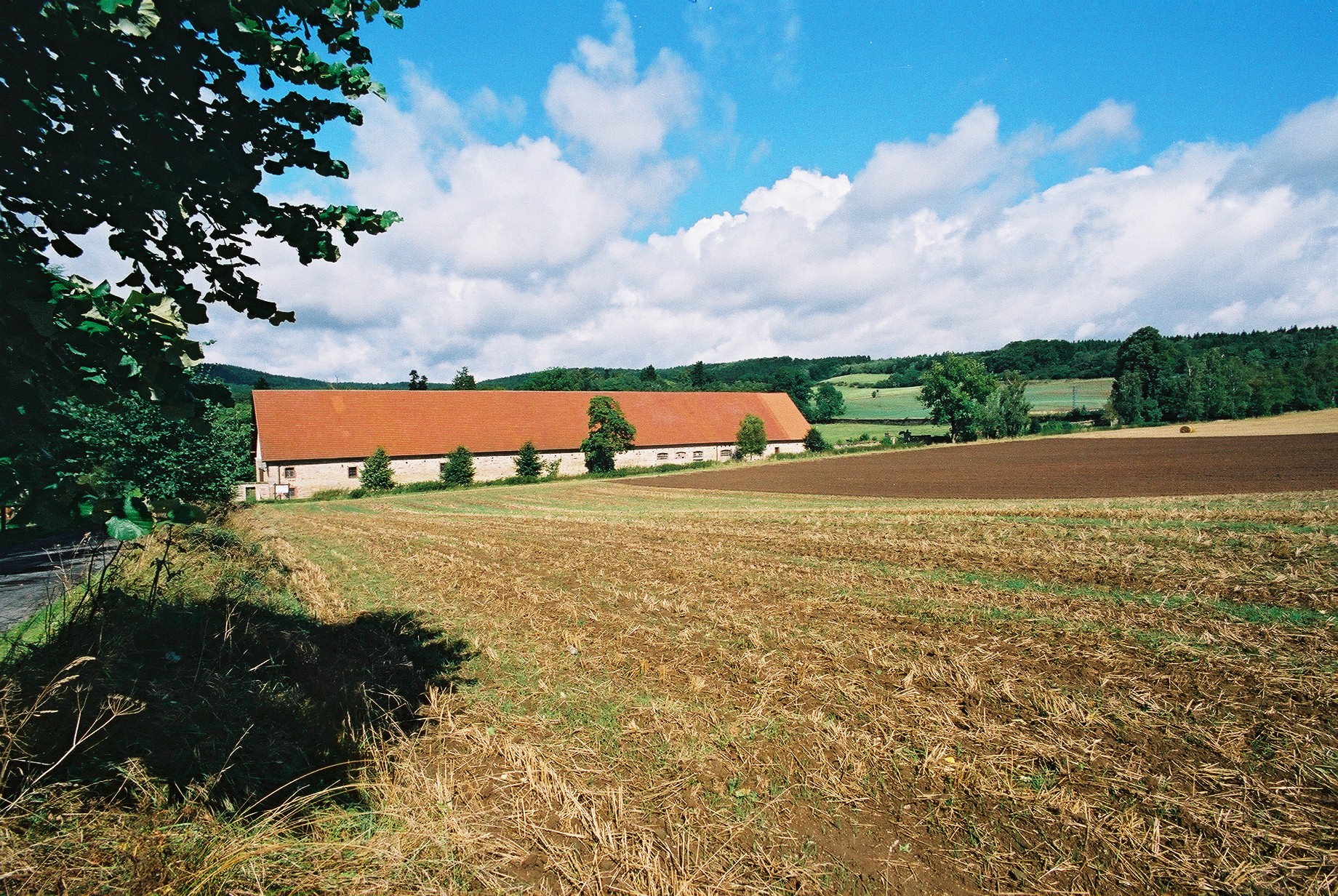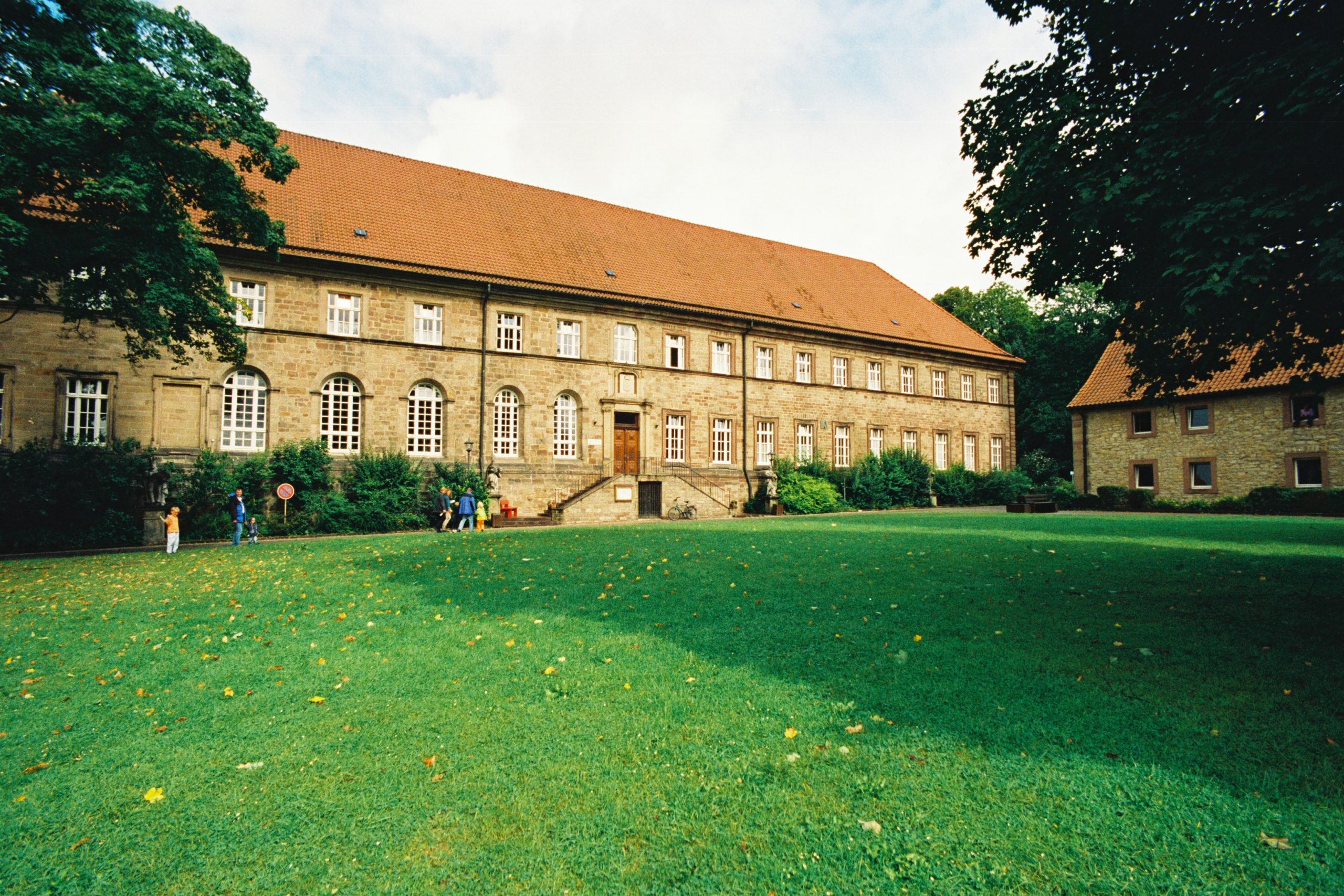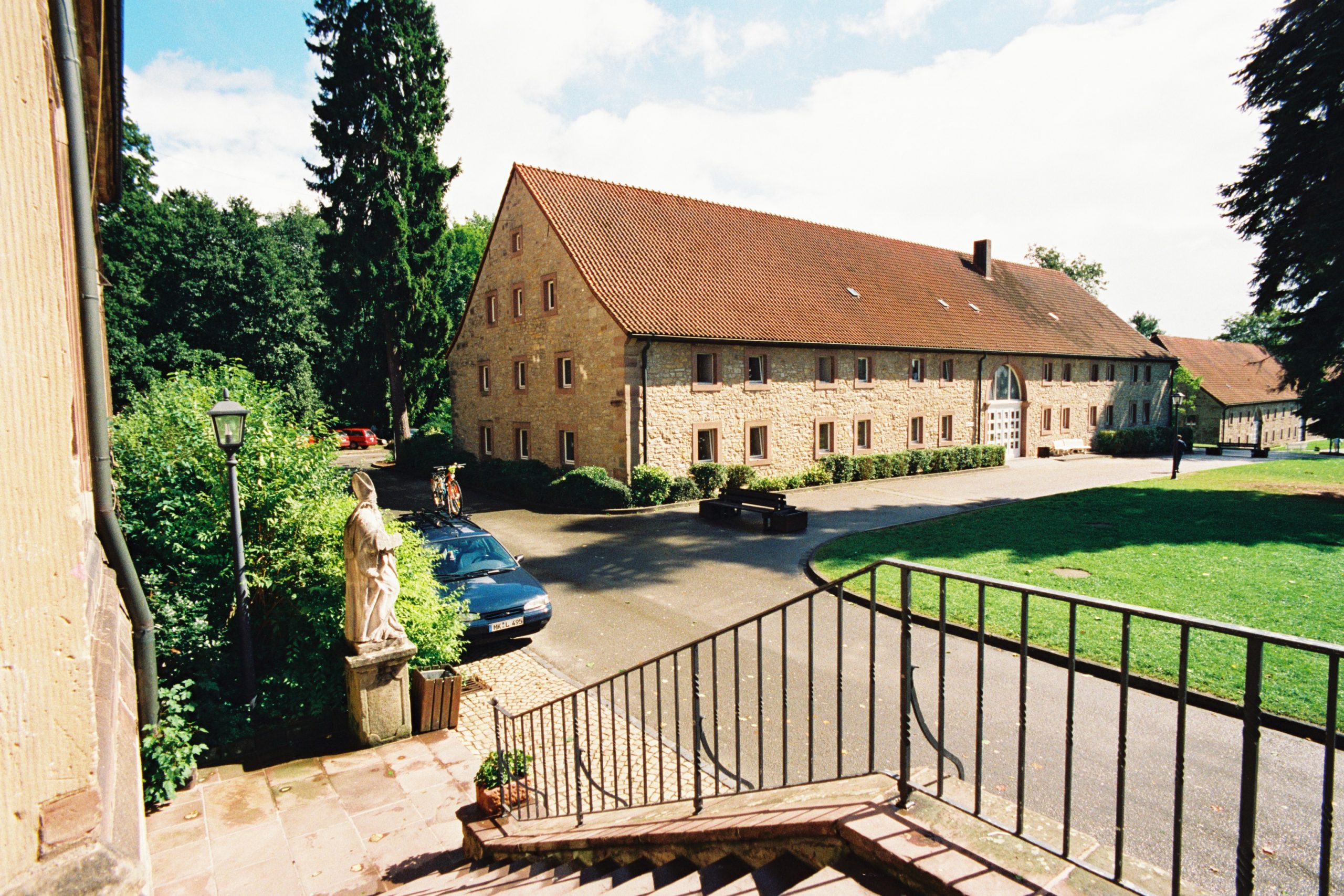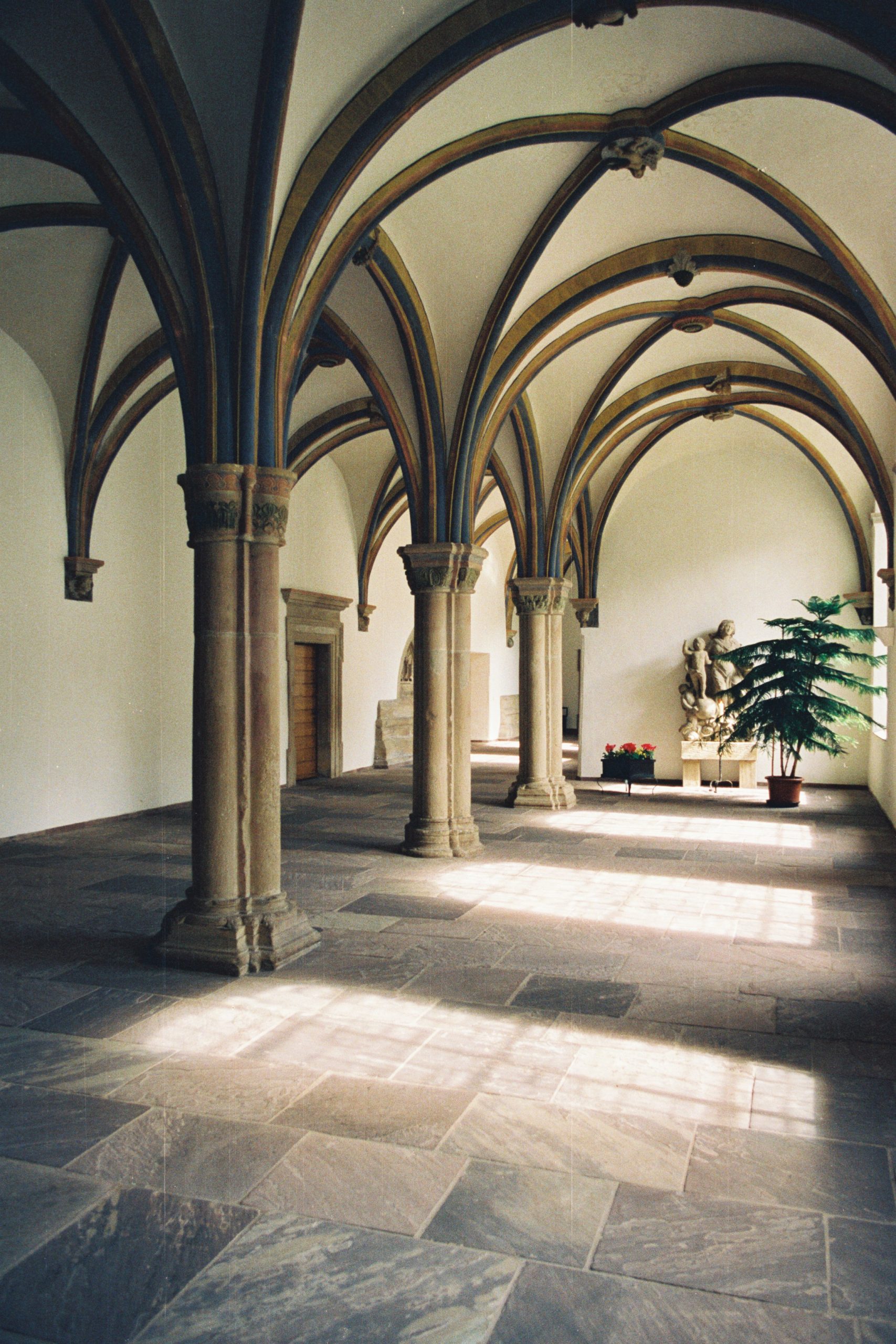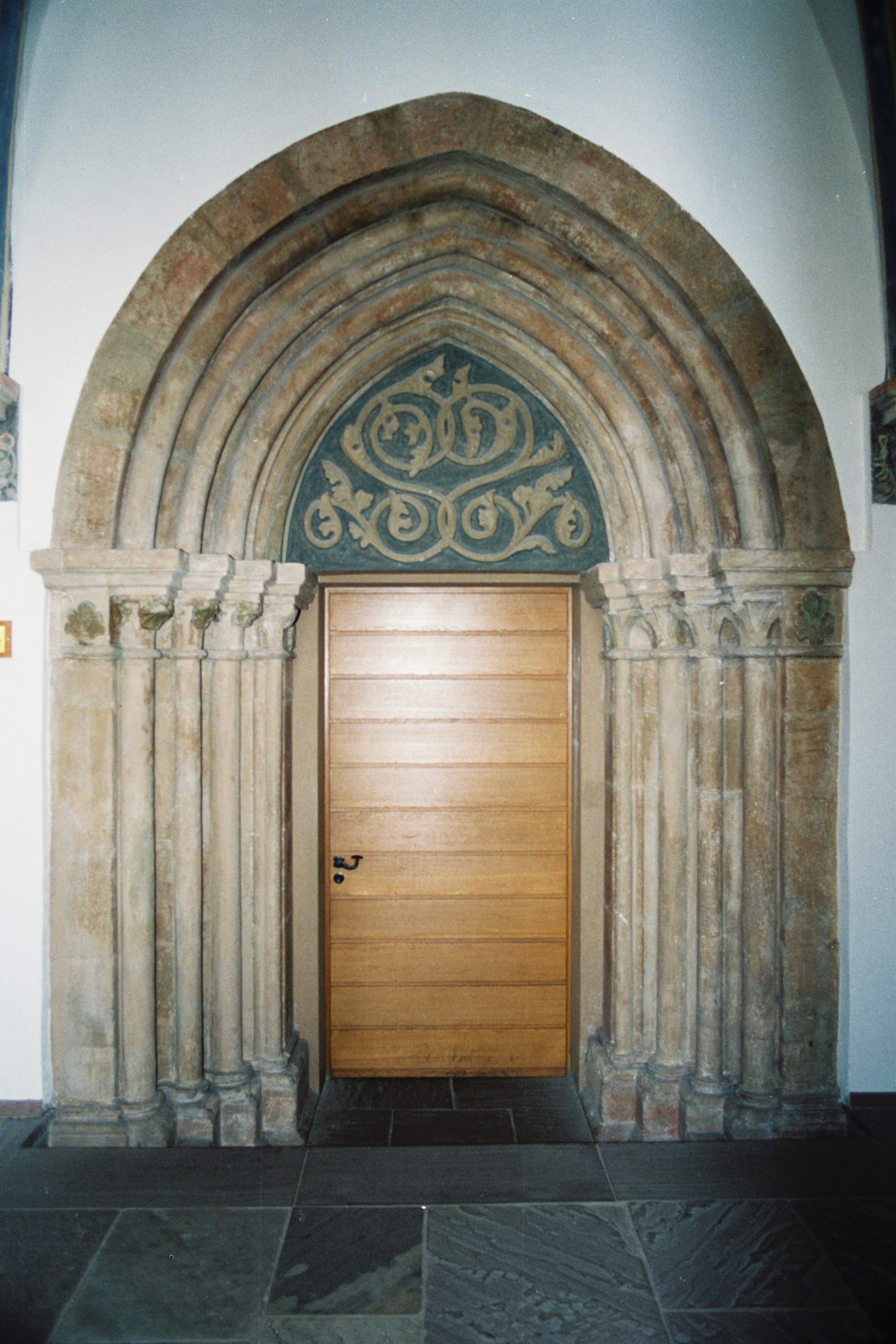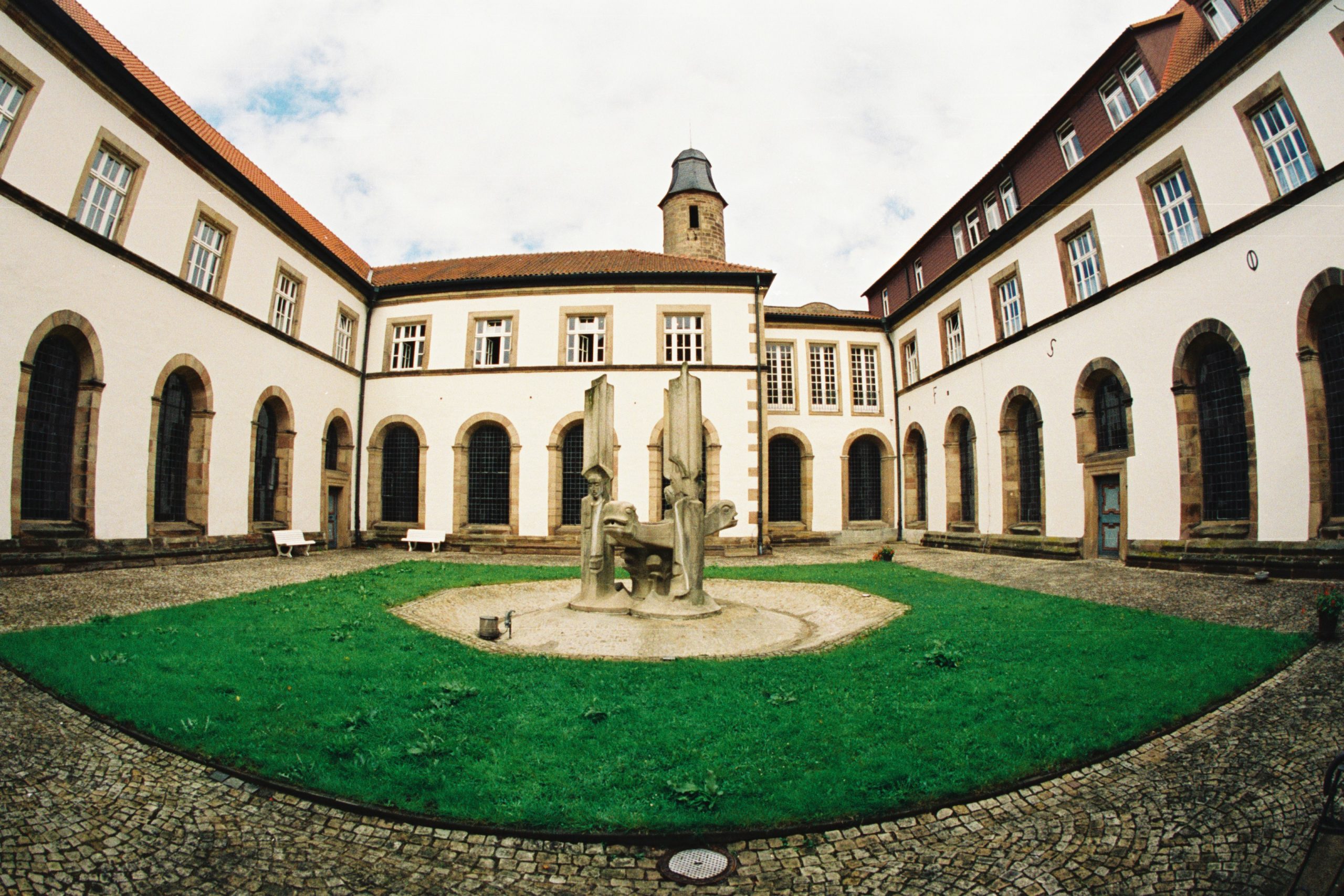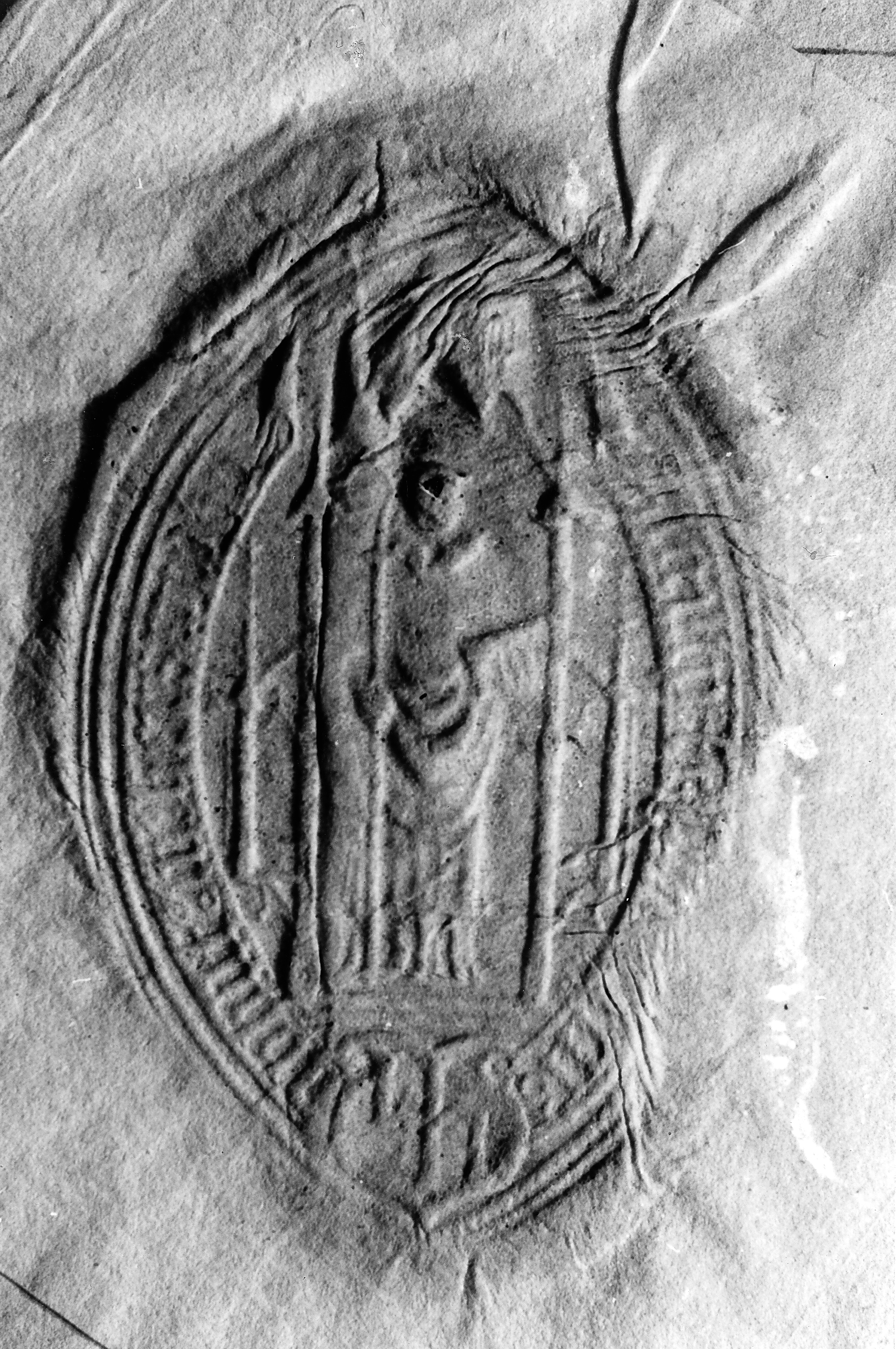Monastery Abbot (1544 to 1567) of the Cistercian Monastery in Hardehausen
Martin Thonemann – Abt von Hardehausen
In the history of the Cistercian monastery in Hardehausen, Martin Thonemann from Warburg is named as 41st Abbot. (Abbot = father – was applied to the director of the monastery and was limited in such a way that spiritual paternity and legal management were connected; the term Abbot is only found in the old orders.) Martin ruled in Hardehausen from 1544 to 1567 in a very difficult phase of the history of the monastery.
The foundation of the monastery 1140
A view of the former Cistercian monastery in Hardehausen.
Today, 1992, an educational centre housing the youth centre of the archdiocese of Paderborn and the headquarters of the Catholic state adult education school “Anton Heinen”, founded in 1949.
Hardehausen is about 3 km north-west of Scherfede (today in the municipality of Warburg) in a pleasant and charming wooded valley in the southern part of Egge. At about the end of the first millennium there was a small settlement “Hersuitehusen” in this wooded and marshy wasteland. This settlement was later called Hardehausen. At the request of Bernhard I, Bishop of Paderborn, Cistercian monks came to Hardehausen on 28 May 1140.
In his piety, for religious and pastoral motives, Bishop Bernhard I went to great lengths to secure this monastery foundation in his diocese. The new monastery was to contribute to the increased worship of God and to the further extension of the monastic life in several other places. Presumably on his travels, the bishop got to know the first settlement of the Cistercians in Germany in Kamp (Kamp-Lintfort). This is about 10 km north-west of Moers on the Rhine. He probably admired the industry, great knowledge and experience of the monks in the cultivation of marsh and wasteland (Rhein-Altarm). In any case the strict simplicity of the monastic buildings as well as the deep piety and strict monastic discipline of the hard-working monks appealed to him. As he gave the foundation of a monastery in his territory his full support, and besides this promised rich donations, the required approval from the general chapter of the mother monastery in Morimont/France came soon.
According to the statutes of the order, in 1140 Kamp Monastery sent apart from Abbot Daniel twelve monks (like Jesus – 12 apostles) to Hardehausen. The area was perfectly suited as the location for a Cistercian monastery – in the opinion of the newcomers – for the pious meditation of God as well as for cultural work. “Because the ways of the world had forced their way into the monastery, a form was sought which kept the world at a distance. Therefore the location in remote wooded valleys and the endeavour to satisfy the simples needs alone.” (F. Winter: The Cistercians of North-east Germany)
This was the beginning for difficult, but blessed work in Hardehausen, which was to bear fruit not only for neighbouring Scherfede and the surroundings, but for the whole Paderborn area.
Generous donations, the exchange of land and its additional purchase, especially the generosity of Bishop Bernhard from Oesede ensured a well-rounded property. (Note: surnames came gradually into fashion in the course of the 12th century because by then the first names in use to distinguish a person were no longer sufficient. Mostly the place of origin or the birthplace was added to the name.)
In any event 15 years passed before all the monastic buildings were finished, surfaces cleared and cultivated and the necessary economic basis had been created for the monastery. Numerous negotiations with previous owners in the area, with Corvey Monastery, Duke Heinrich dem Löwen and Earl von Everstein and Schoneburg had to be concluded before the ceremonious contract of foundation could be signed on 15 May 1155 in the presence of numerous secular and clerical guests.
A partial view of the former Cistercian monastery (founded 1140) – coming from Scherfede.
The Cistercians
For a better understanding of the effectiveness of the monastery throughout the centuries, a brief mention of the Cistercians and their founder follows.
The Cistercians started at the end of the 11th century in the Benedictine reform monastery Citeaux (Cistercium) (French Departement Cote d’Or) under Robert von Molesme in 1098. The Abbey “Abbaye Notre Dame de Citeaux” is 23 km south of the city of Dijon at the crossing of D 996 from Dijon to Seurre with the D 8 from Nuits-St. Georges to Brezey-en-Plaine, 11 km east of the city of Agencourt. The founder of the Cistercian monastery, Abbot Robert von Molesme, born in 1027 as the son of well-off parents in Champagne near Paris, was Prior and Abbot of various monasteries. In 1073 he had been Head of a group of settlers in the woods of Collan, with whom he founded “Molesme” in Burgundy in 1075. This was a monastery with Benedictine character. The aim was to prepare a “Home in the Lord” for the many aimless and baseless roving itinerant preachers, mendicant friars and hermits. At the beginning the residents of the Abbey lived exclusively according to the rules of St Benedict from Nursia, which ran “Ora et labora”.
Especially in its ecclesiastical culture, the time around 1075 was a very unsettled epoch, sometimes affected to the marrow. High ecclesiastical offices could be bought by secular lords. In many places the allocation of ecclesiastical offices, denounced as simony, had shown itself in a display of splendour in architectural style and way of living, which brought a corresponding lifestyle with it. Ecclesiastical property and monasteries were plundered, priests and abbots humiliated. Uncertainty was widespread. Especially where orderly circumstances made a monastery stand out or even where a modest wealth was accumulated, achieved perhaps by donation, to support a community or commune. Its modest prosperity secured a good livelihood. Pope Gregor VII’s battle against simony met with only partial success. After his death the decay of a healthy Church, was shown not only by a pope and anti-pope, rather the crusades from the end of the 11th century up to the 13th century shook the occident to the Near East and North Africa.
Finally the monasteries fought among themselves because some showed allegiance to the rightful pope, others to the anti-pope. This was a time in which right and justice were demanded. In this uncertain flux the steadfastness and conviction of honourable, devout men and women went to pieces.
Therein lies the explanation as to why not only many people set out in search of the truth, to practise the contemplative life in the hermetic lifestyle, but also why charlatans confused the people with big speeches. This group under the blanket term “itinerant preachers”, wandering men, tried to fleece the people, to transform words of emotion into money. In addition these people robbed the church of its good name. However this time of great uncertainty and of general decay of moral values, a lack of orientation for life and the crippled church rocked to its foundations, was opposed by a counter-movement with reflection on the original Christianity and faith in Christian belief.
That was the time in which Robert von Molesme opened his new monastery to all that had set out to dare to attempt to approach God by prayer in solitude.
Molesme Monastery developed very strongly in the first few years, however in the course of time Abbot Robert could not quell the widespread irregularities, laxness and personal excesses of the monks with the necessary strictness. He was a man of goodness and humility, constantly guided by the wish to put the Benedictine strictness of rule into practice and maintain it. Thus he decided with some followers after long, secret discussion, to found a new monastery in which a meditative way of life could be achieved. In 1098 Robert founded Citeaux, a monastery in the forest, with 21 like-minded monks. The Monastery was to distinguish itself by strict repentance and poverty. Before leaving Molesme, Robert and the monks accompanying him had to subject themselves to heavy floggings. A law of the time stated that no monk was allowed to leave his monastery. He was not allowed to leave his originally chosen monastery or to swap with another. A fleeing monk was allowed to be put up for a maximum of one night in another monastery. Every prior was obliged at the time to strongly recommend level-headedness to fleeing monks and a voluntary return to their abbey. No other monastery was allowed to grant accommodation to an imprudent monk. For lawbreakers there was occasionally even jail, abuse and flogging as an instrument for reasonableness and improvement. A year and a half after he had moved out, Abbot Robert, due to a complaint of the monks who had stayed behind, was forced to return to Molesme by order of the archbishop and the instruction of Pope Urban II.
The main building of the former Cistercian monastery in Hardehausen – in 1803 its dissolution was decreed by King Friedrich Wilhelm III – today state adult education school under the auspices of the diocese of Paderborn.
It was through Bernhard von Clairvaux, who as a 21-year-old in 1112 asked to be taken into the Citeaux forest monastery, that the Order achieved great esteem and dissemination in later years. From this time on Citeaux Abbey experienced an unexpected, energetic upswing. Young Bernhard soon began to implement reformatory efforts in the monastery. He was an advocate of the strict Benedictine rule. The Cistercians spread out from Citeaux Abbey. The young Cistercian monks were also called “Bernhardines”.
Clairvaux founded by Bernhard von Clairvaux in 1115 was an abbey of the Cistercians in the French Departement of Aube. Clairvaux is about 60 km east south-east of the city Troyes, 14 km south-east of Bar-sur-Aube in the forest of Clairvaux. The motorway from Troyes (A5/E54) to Beauchemin – Dijon passes 4 km southwards; a visit to Clairvaux is not to be recommended; the big complex of buildings is today (1994) in the possession of the French legal administration. There is a prison there (with a security wing and watchtowers). Only few can enter on special appointment.
The expansion of the Cistercian movement was so radical that at the beginning of the 14th century more than 400 monasteries had been established, especially in France, England and Germany.
Compared to the Benedictines, the constitution of the Cistercian order was more centralised. As a basis for of the centralised foundation of the Order, the “Charta Caritatis” was introduced under Stephan Harding in 1119. The big upswing was based on the excellent agricultural cultivation of the Cistercians. The East German colonisation of the time to Weichsel was in large part carried out by them. From the 14th century an internal decay showed itself again and again; among the Reformation movements the Trappists were the most successful. The Reformation, the French Revolution and secularisation contributed to the downfall of most of the monasteries. The first Cistercian monastery founded in Germany was the monastery in Kamp (Kamp-Lintfort) already mentioned; Hardehausen was the fourth daughter monastery in Germany and the first in the diocese of Paderborn.
Bernhard of Clairvaux
A short description of the life of Bernhard of Clairvaux is added here because the name Bernhard is chosen again and again in the history of the family. Bernhard of Clairvaux was certainly one of the most powerful men of his time. He was born in 1091 in castle Fontaines near Dijon as the son of the knight Tecelin from the lineage of the Earl of Champagne and his wife, the pious and noble Aleth. Bernhard lost his mother when he was 14. The very gifted boy amazed his teachers at the school in Chatillon by his rapid progress. The fame of science or the glamour of the knight’s life beckoned. His being had something so fine and noble that he won everybody and everything for himself. At the age of twenty however, the scientifically highly educated young man decided to renounce worldly life and to live the divine one. The young boy chose the order in Citeaux because of its strictness. By means of his rare talents, an amazing and winning eloquence, he was able to convince his five brothers, his father, his uncle and 20 others to follow him into the strict life of the Order.
Due to Bernhard’s zealous work the number of monks became too high for Citeaux. He left the monastery and settled in “Wermuththal”, gloomy, feared and avoided due to ambushes by robbers. However due to the hard work of the monks this desolate, deserted area was soon changed into a big garden; the valley was called “Claravallis, Clairvaux, Lichtental” due to the light that was sought and found here.
At the early age of 25, Bernhard was elected Abbot of Clairvaux. This monastery in Clairvaux became the mother monastery for many further foundations. Among contemporaries the eloquence and power of the word became famous; “His voice was strong, his articulation clear, his knowledge of scripture and of the fathers extraordinary, his imagination inexhaustible in ever new convolutions of a topic, with scholars he spoke like a scholar, with farmers, as if he had always lived with them.”
“The pale monk with the blond beard and hair is an adviser of sovereigns, of kings, of bishops, of popes; from the tranquillity of his monastery he guides the world. To unite Europe in faith and strengthen it against Islam is the aim of his life”.
In 1153 at the age of 63 Bernhard died; in 1174 he was canonised on account of “the grandeur of his way of living, the fervour of his zeal and the purity of his teaching”. At the time of his death there were 346 Cistercian monasteries founded by him in west and east Europe. These lived according to the strict rule of Citeaux and revered Bernhard as their father.
The economic base of the Hardehausen monastery
The certificate of foundation for Hardehausen monastery was signed in 1155; the beginnings of the Cistercians on this beautiful piece of earth had already been made in 1140. But not until 25 years after the beginning, in 1165, was it possible for the ceremonious consecration of the monastery and church by Bishop Evergis from Paderborn to take place.
The founding bishop Bernhard I died on 16 May 1160; at his wish he was not buried in Paderborn Cathedral, but in Hardehausen monastery church (in the choir in front of the main altar). The later bishops of Paderborn, Evergis (1160 to 1178) and Siegfried (1178 to 1188) guaranteed the care of this monastery. It is known that the bishops of Paderborn maintained a close connection to the monastery not only during the relatively long foundation phase, but also for many years later. Rich donations prove this. The monks for their part showed their gratitude for this help by putting particularly great efforts into their cultural work and their support by prayer. By their own generous performance and also by acquiring additional properties, also outside the immediate vicinity of Hardehausen, a healthy economic basis was provided for the hastily growing convent with the large number of monks and lay brothers (mostly tradesmen and farmers – in contrast to the monks they wore brown cowls with hoods).
From the steps to the main building former farm buildings of the monastery can be seen on the left. Today these are used for conferences.
The administration of the large, cultivated agricultural areas under their own power (keeping to self-management) provided a solid prosperity. Initially the economic base was pig breeding and fattening. The feed basis was facilitated by the big oak and beech woods with pigsties built there. Another task was the taming of wild horses as strong agricultural helpers. The keeping of bees was also promoted; the resulting wax was used for ecclesiastical and everyday purposes.
In the 13th century as the demand for wool became stronger and stronger, the monastery provided for the satisfaction of demand with extensive sheep-breeding and the erection of weaving mills. The big shoemaker’s always had enough to do when it is considered that the convent in its heyday had up to 450 monks and lay brothers. Big and small fish ponds – some can still be seen on the former monastery site – provided for an abundance of fish, especially as the rule of the monastery prescribed fish as the staple food. Eating meat was strictly limited, for a time even forbidden. Fruit and vegetable cultivation acquired a high level among the Hardehauser Cistercians and became an especially productive agricultural branch in the Paderborn Land; the Hardehausen monastery apple is still known there (1994).
The former cloisters of Hardehausen monastery have been preserved.
The monastery on the way becoming the biggest property owner in Paderborn Land
The internal development of the monastery in Hardehausen was completed with the consecration in 1165. Now the task was to round off the property; consequently big properties had to be acquired. That was achieved by the purchase of the Scherfede administration and all the property belonging to Corvey monastery for a price of 584 Denare in 1223. Likewise by purchase, partly also by donations, Hardehausen monastery took over ownership of the entire property of Earl von Everstein. Thus around 1350 the major part of the land in Scherfede, amounting to 60 hides (1 hide = 7.5 ha), was owned by the monastery. Also in Rimbeck, Nörde and Bonenburg, small villages between Warburg and Scherfede, also farther north, lots of land was acquired; thus these settlements also became administrative villages of Hardehausen. The big properties in these villages required the establishment of administrative offices of the monastery, called “Ämter”, these exercised property rights, sometimes also judicial authority. Their character as monastic office villages was retained until secularisation. The main farms in the scattered properties were mostly walled for reasons of security, but always enclosed. The whole property was under the commercial head, a brother from the monastery, who was called “Kellner”.
Additional purchases were also made outside the actual area of the monastery; the idea here was that in the remote properties either new monastic foundations were to be made or at important places and junctions night lodgings were to be provided for travelling members of the monastery. Within this scheme of things, a vineyard was purchased in Kessenich near Bonn and a farm in Fritzlar. The actual task of the monastery, the reclamation of fallow land was always kept in mind. Thus the monks increased the value of their property, but also gave a stimulating and emulating example for other property owners in these areas. The main farms or also the lodgings were later attached to tithe barns, in which the tribute was collected or also crops and products from the livestock to be sold in the towns were stored.
The monks used to go from the cloisters through this door to the refectory. Today (2001) this house is the Klaus Chapel.
Of course the monastery also maintained a lodging in Warburg, Sternstr. 27 – still in existence today. The economic power of the Hardehausen monastery can be completed with the fact that the fishing rights in the Diemel from Billinghausen to Ossendorf belonged to the monastery and that permission to hunt applied to the whole monastic property. The monastery owned a total of 7,500 Morgen forest (1 Morgen = 0.25 ha). Thus – around 1350 – Hardehausen was the biggest ecclesiastical property owner in the diocese of Paderborn.
More than 200 years of continuous building up and extending of property, rich donations from nobles and free farmers, especially the unflagging industry of the members of the monastery and clever commercial management on the part of the leaders of the monastery led to this notable high point. In addition came the constant financial embarrassment of the nobles and the sovereign bishops, also of the neighbouring monasteries. This enabled Hardehausen monastery, with a solid financial basis, to make small and large loans, which in turn bore interest. Strict parsimony at home also won pious allowances of noble donors, mostly leading to a new purchase. For all the men of the monastery the basic principle of the Cistercians “Pray and work” paid off.
The low point for Hardehausen in the 16th century – the dissolution 1803
In these years – middle of the 14th century – Hardehausen monastery experienced its heyday. The big property was consolidated and the zealous cultural work bore rich fruit.
The religious life reached an internal depth, radiated love and fear of God, this could be felt in the whole monastic sphere of action.
Strict fasting, only two meals daily, absolute silence and observation of human dignity as well as gratitude to the maker, all this preserved the real spirit of monastic life. The spiritual culture, the promotion of the common choral singing, occupation with philosophy (Thomas von Acquin), copying valuable religious books – a valuable book of gospels has been preserved – the beautiful architecture, provided the foundation for a smooth life together with God, for harmony and a real Christian community within the monastic community. The unison of prayer and work striven for was achieved in a masterly way.
But is everything not subject to the law of rise and fall? Nothing stays the same, everything is affected by change. The number of monks was limited to 40 in later years, the number of brothers to 300. The time of infringements of the monks and laymen of the monastic rules set in. There were also particularly serious cases of offences (see the following sections “contemporary historical background – referring to Hardehausen monastery” and “Martin’s election and his difficult period in office”): The internal structure of the monastery was greatly changed by the task of the self-reliant economy. The monastery in Hardehausen experienced its lowest point in the 16th century. By 1600 the number of monks had sunk to 18. After the Thirty Years War the monastery had only six monks.
In 1803 (29 January 1803) by Cabinet order of King Friedrich Wilhelm III the dissolution of Hardehausen monastery was decreed. In 1927 the monks returned; they were driven out again by the Nazis in 1938. In 1952 the archbishopric of Paderborn bought back part of the property of the Hardehausen monastery. The old monastery buildings with the adjoining narrow sites were set aside by Archbishop Lorenz Jäger from Paderborn for an education house for the youth and as a state adult education school. The favourite foundation of the founding bishop Bernhard I was to continue to be a place of culture, education and spiritual life.
Martin Thonemann, Abbot of Hardehausen from 1544 to 1567
Martin Thonemann, originally from a Patrician family in Warburg, was elected 41st abbot in the history of the Cistercian monastery in Hardehausen. Martin ruled from 1544 to 1567 in a very difficult period of the monastery’s history.
Contemporary historical background – related to Hardehausen monastery
The contemporary historical background was already mentioned in the previous section “Hardehausen monastery”. An expansion in connection with monastic events follows.
The predecessor of Martin I was Abbot Johannes VII, who ruled from 1530 to 1543. One of the first acts of his term of office was the sale of the village of Sirixen for 200 guilders to the Dalsheim chapter of the canons due to the high debts of the monastery that he took over. His predecessor, Abbot Konrad III (1519 to 1529), had made various sales in order to maintain the enterprise in Hardehausen. From 1544 there are documents available showing the efforts of Martin I to settle the debts of his predecessors.
Paderborn Land was not spared the effects of Martin Luther’s theses on the door of the castle church of Wittenberg on 31 October 1517. The Abbot of Scharmbeck, the third daughter monastery of Hardehausen, converted to the Lutheran teachings. The “new doctrine” and the conversion of the Abbot of Scharmbeck stirred up Hardehausen monastery internally. Tensions rose. On top of that, just at this time, differences and border disputes with Warburg arose. The monastery went into decline. Towards the end of 1542 Bishop Hermann von Wied, who was ruling the royal bishopric at the time, crossed over to the Protestant faith and a few years later ordered the “Augsburg Confession” to be adopted in his whole dioceses. The whole cathedral chapter of Paderborn opposed this instruction.
The “Augsburg Confession” was the basic creed of the Lutheran Church, which had to do with the faith and doctrines of the Evangelists and the redressed abuses of the Catholic Church. It was constituted for the Reichstag of Augsburg (1530) called by Kaiser Karl V, at which a balance between the religious and political opposites was to be arrived at, which came into being through the Reformation.
In 1552 something very unusual happened: The monk Cord von Brackel had a big argument with his prior during which he hit the prior in the monastery church. The perpetrator was quartered alive before Scherfede – as we are told – and the four parts were displayed in the four monastic villages “for the terrible fright and reflection of all despairing, disobedient monks”.
The tensions in the monastery pushed to a solution. In June 1553 Abbot Johannes VII of Hardehausen requested the Abbot of the mother monastery Kamp at this stage to carry out the already planned visitation – as was customary anyhow every 3 to 5 years – and to restore order in Hardehausen. However this did not happen as Abbot Johannes VII resigned prematurely on account of the great difficulties at the time and especially those in Hardehausen monastery. After his resignation on 31 May 1543 Borgentreich monastery farm – 12 km north-east of Warburg was made available to him as a place suitable to his station – as is said in the document.
The prior of the monastery ran Hardehausen monastery after the departure of Abbot Johannes VII until the election of a new abbot.
A modern fountain system in the courtyard of the former Hardehausen Monastery.
Martin’s election and his difficult period of rule
With the new election the tensions of the convent broke out again. Those monastery members entitled to vote who sympathised with the “Augsburg Confession” chose Moritz (the “newer”) as Abbot. However they remained in the minority in the count and lost to the legal majority of voters who in 1544 elected Martin Thonemann Abbot of Hardehausen as successor to Abbot Johannes. Martin came from the Warburg family of Johann Heinrich Thone, called Thonemann, who enjoyed great esteem in the town and had amassed considerable wealth. His father Johann, Conrad’s brother, who was Provost of St. Stephan in Mainz, had married twice. Joist I Thöne, called Thonemann, was born during the first marriage, from the second marriage with Metta Gerold, daughter of the rich Mayor Gerold in Warburg and Anna von Geismar, came Martin Thöne, called Thonemann. As a result of this marriage, the Christian name Martin, customary in the Gerold family, entered the Thonemann family.
Proof of the wealth of the Thonemann family: in 1536 the average citizen in Warburg paid 1 – 2 shillings in “Schott und Pflicht” in the old town of Warburg; even the amount of 3 shillings was rare; only two councillors gave 10 shillings. After the death of her husband Johann Heinrich in 1536, Metta paid 14 shillings, as is shown in the old tax lists of Warburg.
From the second marriage, besides Martin, came the brother Johann VI Thöne, 1562 to 1588, councillor and chamberlain in the old town of Warburg Martin became abbot in Hardehausen and thus one of the highest regarded personalities in the royal bishopric of Paderborn.
In order to get the finances of the monastery under some kind of control again, Abbot Martin borrowed large sums of money at various times from his rich mother, the widow Metta Thone, called Thonemann, née Gerold. In 1567, at the sudden end of his period of rule, the total amounted to about DM 600,000 to DM 700,000 (EUR 300,000 to EUR 350,000), converted to today’s values (1994). It took a long time till the final settlement between the family and Hardehausen monastery could be agreed. Five years after the death of Abbot Martin, the three siblings Joist, Johann, and Else settled with the monastery regarding the debt amount. Abbot Martin lived as a rule in the monastery, but not constantly. It is reported from 1550 that he set himself up to live on the main farm in Borgentreich. Can the reasons for this be traced back to the existing tensions in the monastery or is there another explanation for his stay?
On the occasion of the visit to Brenkhausen monastery on 14 October 1558, Martin concluded an agreement with Abbess Agnes Sluters with the Cistercian father Jacob von Dotichem from Amelungsborn Abbey about the office of priest in Brenkhausen and the spiritual care of the women of the order of the monastery there. That Martin had to install a priest from Amelungsborn for these two offices in Brenkhausen, makes us conclude that there was still a difficult situation regarding the convent in Hardehausen and there were no reliable monks available in Hardehausen. This presumption seems to be justified because the priest from Amelungsborn gave up his tasks in Brenkhausen after a short time. Abbot Martin sent the Hardenhausen priest Pater Liborius Bolten to Brenkhausen as the new holder of the position; he fell in love with a woman of the order, married her and converted to Protestantism. The next priest Bernhard Kopperschmied “did even better” as is said in the chronicles of the monastery. He was sent to prison for fraud and theft. The last priest sent from Hardehausen Monastery, Petrus Krantz, was finally expelled from the order due to other serious offences. The relationships between Hardehausen and Brenkhausen continued to be tainted with these events. For the Hardehausen Abbot Martin Thonemann, who in all decisions strove to maintain the rules of the order in love and goodness, these unusual events were a heavy burden and a depressing worry.
Wormeln Cistercian monastery was likewise under Hardehausen monastery. When Anne von Senden the Abbess there died, Martin presided over the polling for the election of an Abbess on behalf of the Abbey of Marienfeld. He took this task very seriously; in individual conversations he got all the sisters to give him their opinions as to which of them came into question as the worthiest and most suitable successor. Katharina von Lohn was chosen (24 April 1561). It was described in a protocol: “The chosen one cried and fainted, on further persuasion did not refuse”. In the presence of other monks from Hardehausen, also of Johannes Focken, who some years later as Johannes VIII became his successor in the office of Abbot of Hardehausen, Martin introduced the chosen sister to the office of Abbess of the Cistercian monastery of Wormeln.
On 15 September 1560 Abbot Martin I sealed the state treaty which had been negotiated about the course of the border between Paderborn and Waldeck. Abbot Martin is named in the document before eight other personalities and in third place after Bishop Rembert and the two Earls von Waldeck.
Martin Thonemann died in 1567
After more than 23 years of beneficial work and responsible exercise of his high office, Abbot Martin I died in Hardehausen in 1567; for the big monastery it was a time of economic and spiritual recovery, but actually only a short break in the stormy time.
Abbot Martin Thonemann was held in high esteem in the royal bishopric of Paderborn. This can be seen from the fact that at the consecration of Rembert von Kerssenbrock (1547 to 1568) on 2 May 1548 in the monastery church of Dalheim he was named as the first of the invited guests. Martin likewise participated at the diocesan synod held in the autumn of the same year, called by the new bishop, for the reform of the clergy.
It speaks for the newly acquired prosperity of Hardehausen, that at the parliament of Schwaney in August 1558 for the assessment of state tax, the highest amount was levied for the monastery of Hardehausen.
It was no easy task for the Abbot and Monastery Director Martin Thonemann with all the inner strife of the times and the great disunity of the monastery convent right at the beginning of his high office, to steer and guide the large monastery property and the numerous monks and lay brothers. A big debt, partly amassed by his predecessors, weighed heavily on his shoulders. Martin had decided for the retention of the Catholic faith and always stood for this decision with all clarity and thus was in opposition to his Bishop of Paderborn and to the opinion of some of his subordinate monks. Blatant incidents in his own monastery and in the communities of the order connected with Hardehausen demanded a great degree of goodness and tolerance, but also a strong and firm hand if religious matters were in question. From his basic belief he was not prepared to take the easier way, a “laissez faire”, but remained true to the faith of his ancestors, defended it his whole life long. He was not privileged to force a new blooming of the monastery of Hardehausen, despite his enormous input, the circumstances were simply greater. Nevertheless he was an important personality with exemplary character and behaviour, his prodigy can be proud of him!
Seal of Martin Thonemann, Cistercian Abbot of Hardehausen Monastery from 16 October 1544 – the old family mark is easily recognisable under the picture of the Abbot.
(source: North Rhine-Westphalian State Archive Münster, Hardehausen document no. 811)
Martin’s seal from 16 October 1544 is in the State archive in Münster – Hardehausen documents; it is the oldest seal of the Thonemann family in existence. Under the picture of the Abbot and the inscription going round there is a family mark, which was also used in 1572 by Martin’s brother Johann VI, 1608 his nephew, councillor Martin II as well as by his brother Heinrich.
It can be rightly supposed that the ancestors in Warburg did not have a coat of arms, but a family mark, which was used for seals on all documents. The mark developed from two right-angled crossed bars; it was used by the old town members of the family as well as by the new town family. The old town Thonemann line extended this mark by adding another line at the two ends of the bars left upwards and right downwards. In this form Martin of Hardehausen also sealed (see seal) on 16 October 1544. The seal of his brother Joist I Thöne, called Thonemann, shows another bar over the vertical one.

